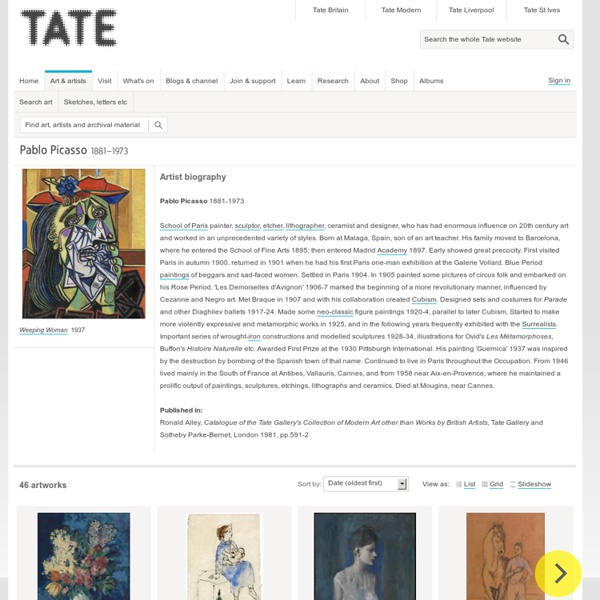



Guernica Web Site As of July 1, 2013 ThinkQuest has been discontinued. We would like to thank everyone for being a part of the ThinkQuest global community: Students - For your limitless creativity and innovation, which inspires us all. Teachers - For your passion in guiding students on their quest. Partners - For your unwavering support and evangelism. Parents - For supporting the use of technology not only as an instrument of learning, but as a means of creating knowledge. We encourage everyone to continue to “Think, Create and Collaborate,” unleashing the power of technology to teach, share, and inspire. Best wishes, The Oracle Education Foundation
Man Ray How Political Was Picasso? by John Richardson Picasso: Peace and Freedom an exhibition at Tate Liverpool, May 21–August 30, 2010; the Albertina, Vienna, September 22, 2010–January 16, 2011; and the Louisiana Museum of Modern Art, Humlebæk, Denmark, February 11–May 29, 2011 Catalog of the exhibition edited by Lynda Morris and Christoph Grunenberg London: Tate Publishing, 255 pp., $60.00 Morir en Madrid by Louis Delaprée, edited by Martin Minchom
Man Ray The Postcards That Picasso Illustrated and Sent to Jean Cocteau, Apollinaire & Gertrude Stein Pablo Picasso’s coterie of friends and collaborators was vast and glamorous. Following his move to France, Picasso befriended the flamboyant Russian ballet impresario Serge Diaghilev, whose Ballets Russes sets he went on to design, and whose prima ballerina Picasso went on to marry. Picasso also became friends with composers (such as Igor Stravinsky) and eminent painters, including his Cubist brother-in-arms Georges Braques, and his compatriot, Juan Gris. Today, we bring you a number of the postcards that Picasso sent to his friends, many of which he personally illustrated, quickly dashing off a note or a picture in a loose, wavy script. Above, you can view an image of Picasso’s postcard to his close friend and artist, Jean Cocteau, depicting the balcony at No. 10, Rue d’Anjou, where Cocteau’s mother had an apartment. In the lengthiest of the postcards, dating from 1919 and provided by Something Rich & Strange, Picasso writes to Gertrude Sein, perhaps describing a holiday: votre Picasso.
Man Ray Craig Raine on Ron Mueck's sculptures | Art and design The story so far. In 1997, at the Royal Academy, the sensation of Sensation: Young British Artists from the Saatchi Collection is neither Damien Hirst's increasingly dowdy, dilapidated, dog-eared shark, nor the homeopathically talented Tracey Emin, whose empty appliquéd tent is an exact objective correlative of her camp conceptualism. Nor is it yet Marcus Harvey's cool, ironic but cynically hyped portrait of Myra Hindley, whose compositional method is denounced by the tabloids - because the face is an agglomeration of childish handprints. Nor is the sensation of Sensation the Jake and Dinos Chapman 1995 fibreglass frieze of girls - naked, prepubescent, wearing only trainers, but sporting several penile noses and open, anal mouths. Among this clamorous, attention-seeking art there is good work - by Jenny Saville, Rachel Whiteread, and the photographer Richard Billingham. The greatness of Dead Dad is oxymoronic: its very completeness also tells us something is missing. Echoes.
ron mueck's figurative sculptures at fondation cartier, paris apr 16, 2013 ron mueck's figurative sculptures at fondation cartier, paris artist ron mueck working on a piece to especially created for an exhibition at fondation cartier pour l’art contemporain in parisimage © ron mueckphoto © gautier deblonde ron mueckfondation cartier pour l’art contemporain, parisapril 16th to september 29th, 2013 the first major exhibition in europe since 2005 of ron mueck opened today at the fondation cartier pour l’art contemporain, paris, unveiling new work by the highly acclaimed london-based artist. to complement six important recent sculptures, the show also includes three pieces produced especially for the event – two teenagers in the street, a mother and baby and an elderly couple on the beach. still life: ron mueck at workvideo courtesy of fondation cartier to complement six important recent sculptures, the show also includes three pieces produced especially for the eventimage © ron mueckphoto © gautier deblonde lara mikocki I designboom